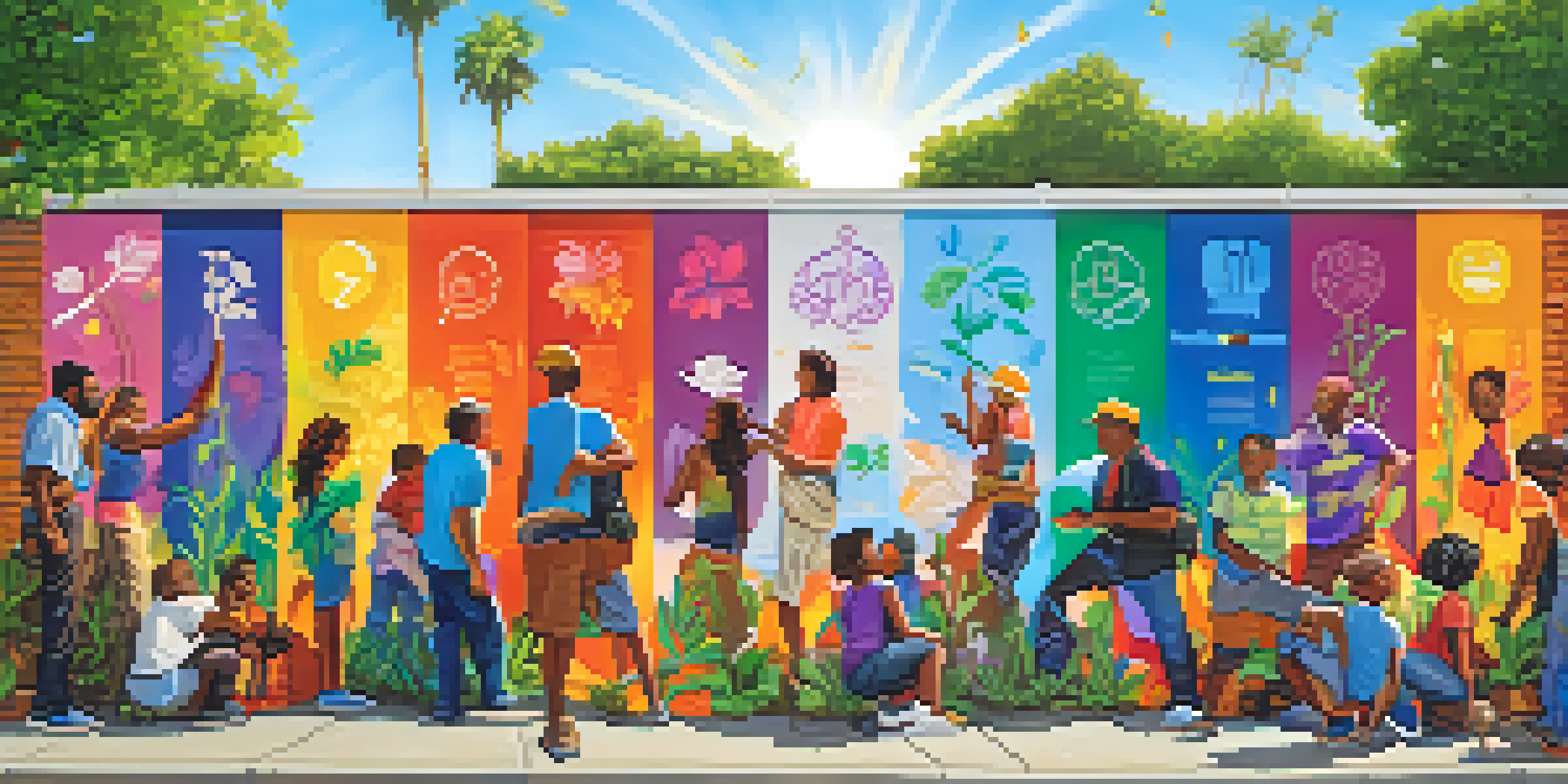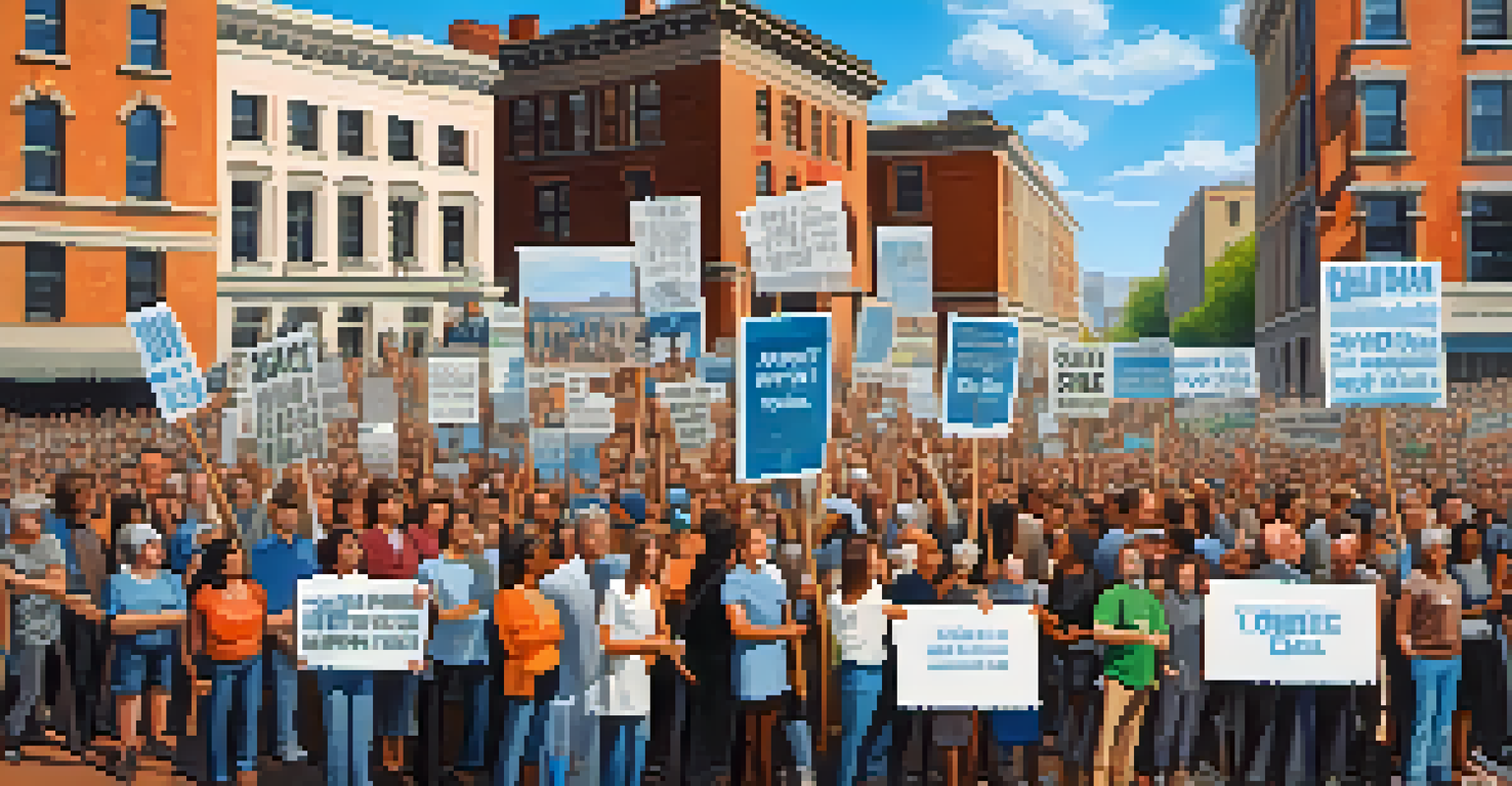Carving Out Change: The Role of Artists in Social Activism

The Historical Connection Between Art and Activism
Throughout history, art has served as a mirror reflecting societal issues and injustices. From Picasso's 'Guernica' to the poignant photography of Dorothea Lange during the Great Depression, artists have wielded their craft to provoke thought and inspire change. These creative expressions often transcend language barriers, making them powerful tools for social commentary.
Art is not a mirror to reflect the world, but a hammer with which to shape it.
In many cultures, art has been used to rally communities, telling the stories of the marginalized and voiceless. The civil rights movement in the United States saw artists like Nina Simone and James Baldwin use their talents to advocate for equality and justice. This legacy continues today, as artists increasingly recognize their role in shaping public consciousness.
By examining the historical ties between art and activism, we can appreciate how artists have not only documented change but also ignited movements. Their works often serve as catalysts, encouraging audiences to reflect, engage, and take action in their own communities.
Modern Artists Leading the Charge for Change
In the contemporary landscape, numerous artists are at the forefront of social activism, using their platforms to address pressing issues like climate change, racial injustice, and mental health. Take, for instance, Banksy, whose thought-provoking street art often conveys powerful political messages. His work invites viewers to question authority and societal norms, prompting dialogue on critical topics.

Similarly, artists like Ai Weiwei challenge oppressive regimes through their art, often at great personal risk. His installations and activism emphasize the importance of freedom of speech and human rights, highlighting how art can be a form of resistance. These examples illustrate how modern artists leverage their creativity to foster awareness and inspire action.
Art as a Catalyst for Change
Throughout history, artists have used their work to reflect societal issues and inspire social movements.
The impact of these artists goes beyond the canvas; they engage with their audiences on social media and in public spaces, creating a shared sense of urgency. By bridging the gap between art and activism, they remind us that creativity can be a powerful force for change in our world.
Art as a Tool for Community Building
Art has the unique ability to bring people together, fostering community connections that can lead to collective action. Community murals, for example, often serve as collaborative projects that not only beautify spaces but also unite residents around common goals. These visual representations of shared values can strengthen social ties and inspire civic engagement.
The role of the artist is to make the revolution irresistible.
Moreover, art workshops and festivals can create safe spaces for dialogue, allowing individuals to express their experiences and concerns. By facilitating conversations around issues like identity, inequality, and justice, art becomes a medium through which communities can explore and address social challenges together. These interactions often spark grassroots movements and initiatives.
The role of art in community building highlights its potential to transform not just physical spaces but also the social fabric of neighborhoods. When individuals come together through artistic expression, they cultivate a sense of belonging and purpose, empowering them to advocate for change collectively.
The Power of Storytelling in Artistic Activism
Storytelling is a fundamental aspect of human experience and serves as a powerful tool in artistic activism. Artists often share personal narratives through various mediums, allowing them to connect with audiences on an emotional level. These stories can illuminate the struggles and triumphs of marginalized communities, fostering empathy and understanding.
For instance, spoken word artists like Sarah Kay use poetry to address social issues, weaving personal experiences into broader narratives that resonate with many. This approach not only raises awareness but also encourages listeners to reflect on their own lives and the world around them. Such storytelling transcends mere information, engaging hearts and minds to inspire action.
Digital Platforms Amplify Activism
The rise of digital art and social media has transformed how artists engage with audiences and mobilize for social causes.
By harnessing the power of storytelling, artists can bridge divides and create spaces for dialogue. Their narratives invite audiences to consider different perspectives, prompting a deeper engagement with social issues and motivating individuals to become advocates for change.
Digital Art and Activism in the 21st Century
The rise of digital platforms has transformed the way art and activism intersect, providing new avenues for expression and outreach. Social media allows artists to share their work with a global audience, amplifying their messages and connecting with supporters across borders. This digital age has enabled movements like #BlackLivesMatter to gain momentum through powerful visual content.
Digital art, including graphic design, video, and interactive installations, offers innovative ways to engage audiences and convey messages. For example, animated short films can distill complex social issues into digestible narratives, making them accessible to wider audiences. This adaptability allows artists to reach individuals who may not engage with traditional forms of art.
In this context, digital art not only serves as a means of expression but also as a mobilizing force. By leveraging technology, artists can inspire collective action and create a sense of urgency around critical social issues, proving that creativity knows no bounds in the fight for change.
The Intersection of Art and Policy Change
Art can play a crucial role in influencing policy change by raising awareness and mobilizing public opinion. Artists often collaborate with activists and organizations to create campaigns that highlight specific issues, drawing attention from policymakers and the media alike. When art evokes a strong emotional response, it can spur individuals to take action, whether through protests, petitions, or community engagement.
For instance, the 'Art for Change' initiative has seen artists create works that directly address environmental issues, encouraging viewers to advocate for more sustainable policies. These artistic interventions can make complex topics more relatable, enabling audiences to grasp the urgency behind the issues at hand. This relationship between art and activism can lead to tangible outcomes in policy discussions.
Community Building Through Art
Art fosters community connections, encouraging collective action and dialogue on pressing social issues.
By positioning themselves at the intersection of creativity and activism, artists have the potential to influence decision-makers and advocate for meaningful change. Their work can serve as a catalyst for conversations that shape public policy, ultimately creating a more just and equitable society.
The Future of Artistic Activism
As we look to the future, the role of artists in social activism is likely to evolve alongside societal changes. With increasing global challenges such as climate change and inequality, artists will continue to adapt their messages and methods to resonate with diverse audiences. The fusion of technology and creativity will further expand the possibilities for artistic expression and activism.
Emerging artists are already exploring new mediums and platforms, from virtual reality experiences to interactive installations, to engage audiences in unique ways. These innovations can create immersive experiences that deepen understanding and motivate action, pushing the boundaries of traditional activism. The future of artistic activism promises to be dynamic and inclusive.

Ultimately, the continued collaboration between artists and activists will be vital in addressing the pressing social issues of our time. By harnessing the power of creativity, artists will remain at the forefront of movements for change, inspiring hope and action in communities around the world.